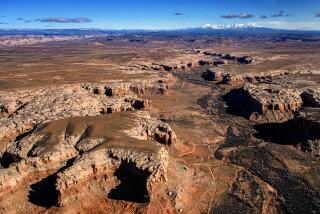Saving the Earth, Satisfying the People : THE NATURE OF DEVELOPMENT: A Report from the Rural Tropics on the Quest for Sustainable Economic Growth, <i> by Roger D. Stone (Knopf: $23; 286 pp.)</i>
In 18th-Century England, the conservationist movement was king. Forests were protected and poaching was a capital crime. Killing a woodcock or a rabbit was punishable by hanging. Englandâs landowners liked nature, and as avid hunters they wanted to make sure that the frowzy peasants would not hunt their precious foxes and pheasants to extinction.
We laugh at gamekeeper environmentalists today, but the âsave the pheasant, starve the peasantâ spirit lingers on. Rich Western sentimentalists weep over the plight of Africaâs âcharismatic megafaunaâ--its cute big animals like the vanishing rhinos and elephants. The sentimentalists have few tears to spare, however, for homo sapiens in Africa. In many of Africaâs game parks today, park rangers fight deadly gun battles with poachers--some members of large scale syndicates, others just local villagers trying to make a living. Nobody hangs to save pheasants anymore, but people still die to save game.
As well they should, sniff certain âenvironmentalists,â who blame Africaâs environmental problems on the sins of its human inhabitants: overpopulation, heedless exploitation of natural resources, and so forth.
We see the same spirit at work in the controversy over the Amazon forests. People who never in their lives gave a thought to the Amazon Indians wring their hands over tropical butterflies. It is easier today to raise money for the Amazonâs trees than for its children--undernourished, uneducated and unvaccinated though these may be.
Naturally enough, this approach drives Third Worlders wild. The âdevelopment economistsâ who see themselves as their advocates thus tend to go off in the opposite, anti-environmental extreme. âScrew the pheasants,â they say. âPower to the peasants!â Dismissing most ecological and environmental concerns, they build dams that flood important natural habitats, burn rain forests to create new agricultural land and organize vast development projects without thought for the consequences.
Too often, the results prove disastrous for peasant and pheasant alike. Poorly conceived dams silt up; diseases spread through the new lakes while fisheries are destroyed; the soil under tropical rain forests turns out to be poorly suited for agriculture. Everybody loses and the peasants, poorer than ever, are driven to more and more desperate means to feed themselves as the degraded environment sinks into a vicious cycle of exploitation and decay.
Given that nobody is happy with this status quo, a new approach has gained popularity in recent years. Environmentalists have understood that without the cooperation of local people, conservation programs cannot work. Developers and engineers have also begun to realize that their ambitious projects will fall short of their objectives unless they are environmentally sound.
The resulting consensus position--still vague and still emerging--is called âsustainable development,â and this is the subject that Roger Stone explores in his fascinating new book, âThe Nature of Development.â
In a field rife with doomsayers, Stone looks for hope--for small projects in the rural tropics where people are living better while taking care of the nature that surrounds them. He finds heartening examples. In New Guinea, mountain people are learning to make more money by conserving forests than by cutting them down. No longer hunting the spectacular indigenous butterflies to extinction, they have organized âbutterfly ranches,â satisfying European collectors while protecting the habitat.
In Thailand, where logging recently threatened to denude the entire countryside, aroused villagers have helped enforce conservation decrees. Rural cooperatives have developed land-use patterns that allow farmers to harvest certain plants in forest preserves while maintaining the integrity of the national parks.
Stone has other stories to tell: of African villagers involved in preserving mountain forests, of Costa Ricans who have adopted farming techniques that are both more rewarding for the farmers and less taxing on the environment than traditional practices, and of Caribbean islanders who are earning more money from the sea by aquaculture and diversified activities than by reckless overfishing of a handful of commercial species.
Yet Stone is the first to admit that, however encouraging the successes he finds, there are plenty of failures, too. The kinds of projects that work are small-scale and intensive. They require dedicated, labor-intensive work from organizers and community developers. They depend also on the cooperation of government authorities that are sometimes insensitive, sometimes controlled by powerful economic interests and sometimes inefficient or corrupt.
The inhabitants of the rural tropics are overwhelmingly poor and uneducated. They have little experience with political organization. Like rural people everywhere, they are instinctively conservative, afraid of the risks involved in changing patterns of behavior that may be centuries old. In many areas, tribes and ethnic groups are embroiled in conflicts over land rights and land use. The widespread oppression of women poses exquisitely difficult problems for foreign environmentalists. Do they acquiesce in destructive local patterns of discrimination and abuse, or do they complicate the environmental project by taking on entrenched local customs?
Stone doesnât minimize the difficulties. Many of the projects he cites have been only partially successful; some have been outright failures. It is clear that the methods used in these projects will not solve the worldâs environmental problems. The projects are too small, and progress is too piecemeal for that. Furthermore, as Stone acknowledges, the cities and the industries of the developing world occupy the center stage in the quest for environmental health.
At the level of rural farming villages or fishing settlements, sustainable development is easy to understand though hard to implement. The concept becomes much murkier when applied to the industrialization of an entire country or continent. Given the many doomsday scenarios floating around the environmental movement--global warming, ozone depletion, oceanic pollution--it is questionable whether any country has yet learned what sustainable development really means.
Clearly, the world is just beginning to grapple with environmental issues, and âThe Nature of Developmentâ provides a useful introduction to many of the debates that will be shaping international relations in coming decades. Stoneâs summaries of the history of the international conservation movement, of development economics, and of such current topics as the relation of international trade regulations and environmental concerns are clear, concise and well-balanced.
A vice president of Chase Manhattan Bank, a senior fellow at the Council on Foreign Relations and a vice president at the World Wildlife Fund, Stone is perhaps uniquely qualified to assess and discuss the economic and political consequences of environmental issues. And in these pages, based on extensive travels in the rural tropics and thorough research in the libraries and bureaucracies of the developed world, he has made an important contribution to a growing debate.
More to Read
Sign up for Essential California
The most important California stories and recommendations in your inbox every morning.
You may occasionally receive promotional content from the Los Angeles Times.










